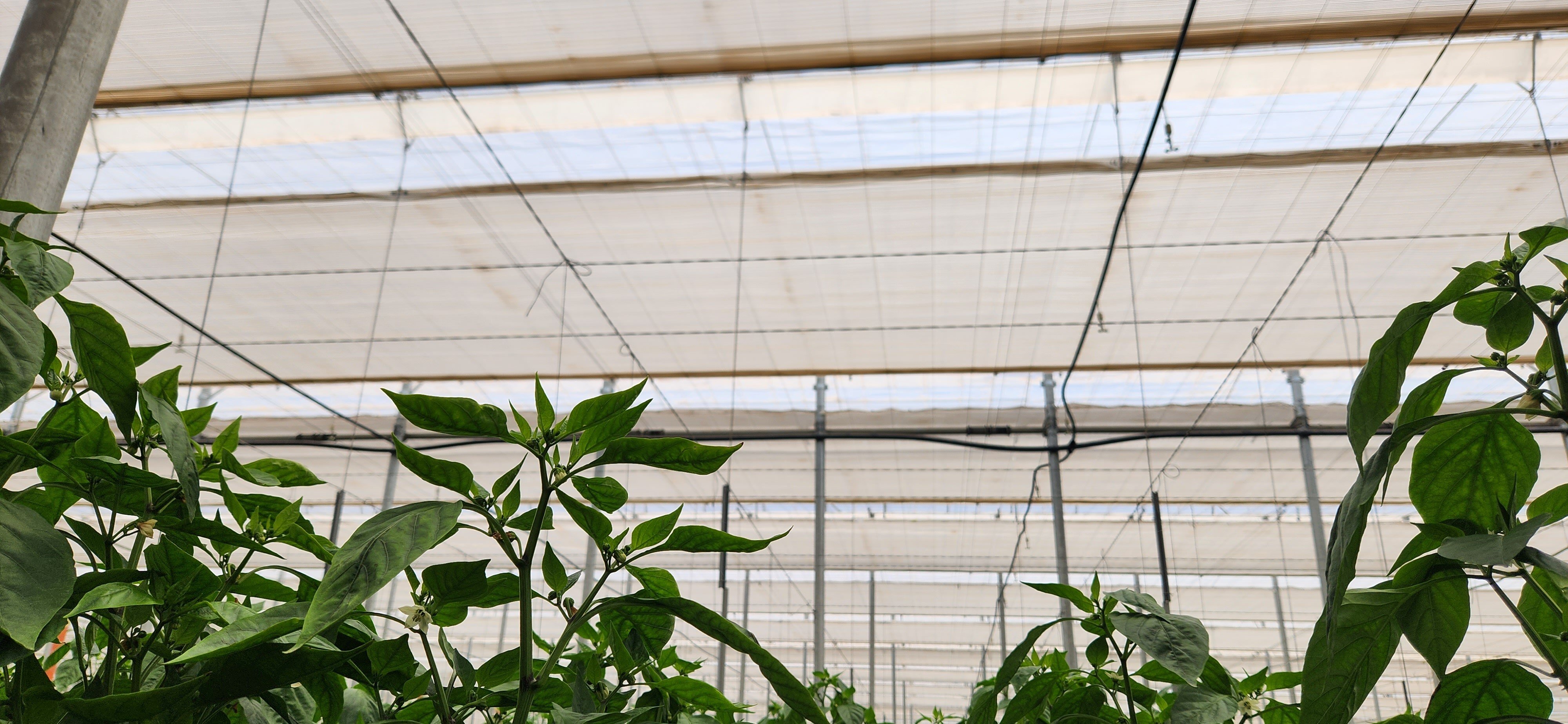
Blazing hot by day but freezing at night

How fixing a customer's problem turned us into night-time heat loss science nerds
In the greenhouse area in Almeria and El Ejido, you often have to follow map coordinates if you want to find your customer.
“No street address?” asked a colleague visiting Almeria for a week.
“How can the customer not have an address?”
Almeria has the highest density of greenhouses in the world – just in Almeria there are over 32000 Ha.
Fortunately, a GPS is happy to aim for satellite coordinates, and the customers know to share them when we make a visit.
Her visit to Almeria was connected with something that was happening to a greenhouse's climate at night. It was as if it was driving along with the brakes on. Something was holding yields back.
We knew if we could find a great solution for the grower, we could really help many of our customers.
It was about this time we all became night-time heat loss nerds.
Anyone who is growing through winter in a traditional greenhouse should be a little nerdy about what happens in the greenhouse at night.
Understanding some of the physics just makes the greenhouse work better.
We travelled to the heart of El Ejido to one of our trials where we made a comparison between a greenhouse which had no screen and another one where we placed a high transmission energy screen to fight against the heat loss at night. The results were good the first year, but they were about to surprise us even more. . Together we decided to run a second year of trials using a screen that is optimized for daytime growing conditions, rather than night-time energy saving – the Harmony 3845.
Was that really the best choice, I wondered?
After all, keeping the plants warmer at night was the initial goal. Here we were shooting for a wider range of variables for the greenhouse, so we felt it was worthwhile.
Night-time heat loss is full of surprises. I think most of us are still a bit stunned by the amount of physics around it.
A good start is to get some terms straight. The key terms are …
- Conduction. Most of us understand that things lose their heat when they touch something cold and lose heat to that object.
- Convection. This is when the crop is surrounded by cooler air. This can be caused when cold air infiltrates, or warm air exfiltrates from the greenhouse.
- Radiation. It can come as a surprise to some that after a very warm day, an open sky at night can lead to substantial infra-red radiation, as energy moves from the warmer crop, to the freezing open cosmos.
 I’m not sure that any of us go around thinking that after a 30°C (86°F) day, a crop could be plummeting near to 0°C because the clouds parted to reveal a clear and open night sky.
I’m not sure that any of us go around thinking that after a 30°C (86°F) day, a crop could be plummeting near to 0°C because the clouds parted to reveal a clear and open night sky.
The physics of radiative heat loss were described by physicists Stefan and Boltzman in the 1880s. They explain why soldiers who had dealt with 40°C (+100°F) and clear skies by day in the first Gulf War, woke up in the desert to find ice on their sleeping bags.
They were radiating their warmth away to the next closest object: space.
“Here is an example of what happens without a Svensson Energy screen in the exterior from the nearest to the far point where the eye can see”

We’ve long been curious about lack of performance of some crops in hot regions during the winter period, and these trials were a great chance to explore and find solutions. We saw huge drops in temperature on clear nights with high humidity and no wind. When this happens the inside of the greenhouse can become even colder than the external temperature an event called thermal inversion.
Without a cloud cover or a screen inside the greenhouse, heat escapes into the atmosphere very fast causing significant energy loss and, in conjunction with poor ventilation and a lack of wind, this can further lower the greenhouse’s internal temperature below the exterior.
We considered various solutions for this problem during the visit.
We had assumed that an energy screen – designed for insulation – would be best at preventing night-time heat loss.
But in fact something as thin as a piece of paper will stop outgoing radiation, at least for a while. It interrupts the line of sight. You might have experienced this.
If you are sitting under a parasol at a barbeque on a hot day and the sun goes down, you might notice a sudden shock of cold when you step out from under the thin sheet of the parasol.
In our case, we realized we could use a shade cloth to reflect the energy back inside the greenhouse as evening came on. It would have the added advantage of being able to shade the greenhouse from peak radiation during day, when temperatures were extreme.
This was a gamechanger. We made the adjustments and prepared for a new trial with our grower. Now, a single Harmony screen would replace the Luxous energy screen in the role of reducing night-time heat loss and the impact of the thermal inversion in the greenhouse.
When we checked the results some way into the second trial, we gathered some remarkable results. We have written these up in a guide called "Thief in the Night", which I highly recommend you check out here.
More participation in the profitable winter market
Hugo Plaisier, Senior Climate Consultant in the Netherlands , and I were chatting about the really encouraging results. We got talking about timing.
He says that ultimately it is our success in taking the chill off these winter nights that makes all the difference.
“It is how cold it gets that dictates how long they can participate in the market,” he said. “The screen gives them an added 1 to 3°C of warmth at night and increases the dew point as well,” he added.
What’s been your experience?
Does this slightly weird science ring true with what you observe on a clear, starry night after a hot growing day? Do you have some data to share? We love data!
I’m going to write a bit more about this in a future blog post, so if you have any experience with thermal inversion or other impacts of night-time heat loss, including how to overcome it, then I’d be interested to hear.
Related articles

What if you know your warmzone climate, but you change to a new pepper crop?
Why show up at greenhouses in Almeria with all my gadgets? The grower’s know the outdoor climate after all. What’s the point in gathering that data..

Once in a century heatwave forces Eastern Chinese growers to review shade strategy
Growers with greenhouse equipment from 10-20 years ago, and even growers with the latest high-tech Dutch semi-closed greenhouses, are having to..
